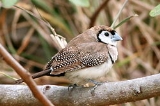
Double-barred Finch
Encyclopedia
The Double-barred Finch Taeniopygia bichenovii is an estrildid finch
found in dry savanna, tropical (lowland) dry grassland and shrubland habitats in northern and eastern Australia
. They are sometimes referred to as Bicheno's Finch; and also as Owl Finch, owing to the dark ring of feathers around their faces.
The name of the species commemorates James Ebenezer Bicheno
, a colonial secretary of Van Diemen's Land
appointed in September 1842.
finch with a white face bordered with black, brown upperparts and throat, and white underparts. The throat and underparts are separated by another black line. The wings are patterned in brown and white. The sexes are similar, but juveniles are duller and browner. A less common sub-species with brown or black underparts is known to exist. The call is a soft tet or a louder peew, and the song is a soft fluting.
These gregarious seed-eating birds build their nests in grass, a bush or low tree, and lay four eggs.
Estrildid finch
The estrildid finches are small passerine birds of the Old World tropics and Australasia. They can be classified as the family Estrildidae , or as a sub-group within the family Passeridae, which also includes the true sparrows....
found in dry savanna, tropical (lowland) dry grassland and shrubland habitats in northern and eastern Australia
Australia
Australia , officially the Commonwealth of Australia, is a country in the Southern Hemisphere comprising the mainland of the Australian continent, the island of Tasmania, and numerous smaller islands in the Indian and Pacific Oceans. It is the world's sixth-largest country by total area...
. They are sometimes referred to as Bicheno's Finch; and also as Owl Finch, owing to the dark ring of feathers around their faces.
The name of the species commemorates James Ebenezer Bicheno
James Ebenezer Bicheno
James Ebenezer Bicheno was a British author and colonial official.Bicheno was the son of the Rev. James Bicheno, minister of the Baptist Church in Newbury, Berkshire. He was called to the bar in 1822 but seems to have spent most of his time until 1832 in writing and natural history pursuits,...
, a colonial secretary of Van Diemen's Land
Van Diemen's Land
Van Diemen's Land was the original name used by most Europeans for the island of Tasmania, now part of Australia. The Dutch explorer Abel Tasman was the first European to land on the shores of Tasmania...
appointed in September 1842.
Subspecies
There are two sub-species:- Taeniopygia bichenovii bichenovii
- Taeniopygia bichenovii annulosa
Characteristics
This is a 10–11 cm long munia-likeLonchura
Lonchura is a genus of the estrildid finch family, and includes munias , mannikins, and silverbills. They are resident breeding birds in Africa and in South Asia from India and Sri Lanka east to Indonesia and the Philippines...
finch with a white face bordered with black, brown upperparts and throat, and white underparts. The throat and underparts are separated by another black line. The wings are patterned in brown and white. The sexes are similar, but juveniles are duller and browner. A less common sub-species with brown or black underparts is known to exist. The call is a soft tet or a louder peew, and the song is a soft fluting.
These gregarious seed-eating birds build their nests in grass, a bush or low tree, and lay four eggs.

